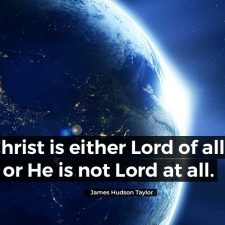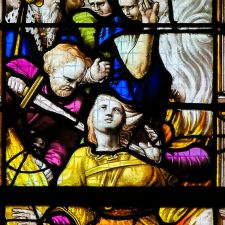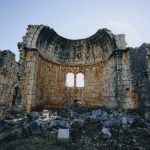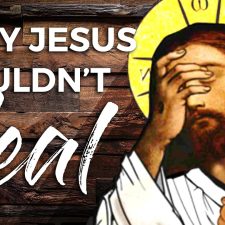A Brief Survey of Faithful Israel Throughout History
Throughout the ages, Christianity has experienced both great growth and great persecution, often in the same breath. In fulfillment of Christ’s words, “In this world, you will have trouble…” (John 16:33), from generation to generation, God’s faithful remnant has experienced trial, even at the hands of others who declared Jesus as Lord. Who is faithful Israel? In this lesson, we journey across history to survey the arc of the people of God, even in the face of terrible persecution.
TAKE AWAYS:
- Error entered even the first-generation Church as they drifted from New Testament teaching
- Persecution came through paganism, Judaism and finally, through the Church itself
- There has always been a faithful remnant, from Noah to today
Early Church: 30-500 AD
Writing in the late 50’s AD, Paul quotes 1 Kings 19:8 as an encouragement to the young Roman church. His message: Though the days may darken and persecution increase, God has always kept a faithful remnant:
2 God has not cast away his people whom he foreknew. Do you not know what the Scripture says of Elijah, how he interceded to God against Israel saying, 3 “Lord, they have killed your prophets and demolished your altars and I alone remain, and they seek my life.” 4 But what did God say to answer him? “I have reserved to myself seven thousand men who have not bowed the knee to the image of Baal.” 5 Even so, at this present time, there is also a remnant according to the election of grace. (Romans 11:2-5)
Throughout the age of the Jews (ending in 70 AD with the destruction of the Temple and the dissolution of the Mosaic rites) and continuing to today (the times of the Gentiles, per Luke 21:24, Romans 11:25), God continues to call His elect. But, who are God’s elect? They were defined by the prophet Malachi when he spoke of a “day of the Lord” sifting following the reappearance of Elijah (Malachi 4:5-6; cf. Matthew 11:14 where Jesus refers to John the Baptist as Elijah.)
…You shall discern between the righteous and the wicked, between one who serves God and one who does not serve him. (Malachi 3:18)
God’s elect are seen again in Revelation 12:17, when John’s vision tells us:
The dragon (Satan, the enemy) was furious with the woman (faithful Israel), and went to make war with the remnant (the faithful Church) of her seed (Jesus, the Jewish Messiah), those who keep the commandments of God, and who have the testimony of Jesus Christ.
Our definition is clear then: God’s elect are those who remain true to God, following Him and the one He sent, the Messiah, Jesus of Nazareth.
Division Enters the Early Church
Though it’s often proposed the fracturing of Christianity began with the formation of the Roman state church—denominationalism, also known as sectarianism—had taken root in God’s holy people long before. Denominationalism can first be seen in the division between the Jews and Samaritans, and again as the Jewish cult continued to splinter, first into the Pharisees and Sadducees, then the Essenes, and soon after, the Zealots. In fact, as Christianity exploded onto the scene during the Pentecost of Acts 2, both Jew and Gentile viewed Christianity as simply another sect of Judaism. In its earliest days, the Church was, after all, a mainly Jewish population believing the prophecies of Israel’s Messiah had been fulfilled in Jesus of Nazareth. Indeed, Judaism had split again, this time between those who believed Jesus was the Christ, criminalized and crucified upon a Roman cross, and those who still awaited another. This explains why persecution from Jewish religious leaders was so fierce (cf. Acts 23, 25:3, 26:9-11, etc.) Christianity was seen as a blasphemous aberration threatening to consume those faithful to the Law of Moses; it had to be stamped out.
Throughout the New Testament, evidences of this division can be seen. Likely the result of the ongoing conflict between Jews and Christians, the Roman historian Suetonius writes about the expulsion of Jews from Rome under Claudius Caesar, also seen in Acts 18:2:
“He banished from Rome all the Jews, who were continually making disturbances at the instigation of one Chrestus.” (Divus Claudius 25. Chrestus was a popular Greek and Roman variation of Christus, meaning “the anointed one,” an obvious reference to Jesus.)
Perhaps Galatians 4:22-31 best illustrates the division between Old and New Covenant Judaism:
22 For it is written that Abraham had two sons, the one by a bondmaid, the other by a free woman. 23 But he who was of the bondwoman was born after the flesh, but he of the freewoman was by promise. 24 This is an allegory: for these are the two covenants; the one from the Mount Sinai bearing to bondage, is Hagar. 25 For this Hagar is Mount Sinai in Arabia, and represents Jerusalem which now is, and is in bondage with her children. 26 But Jerusalem which is above is free, which is the mother of us all. (v22-26)
So maybe it should come as no surprise when we see the early stages of division creeping into the Christian Church by the time Paul writes his first letter to the new church in Corinth. A mere 20 years after Jesus, Paul has become aware of quarreling within the Corinthian body and he exhorts that there be “no divisions among you”:
“12 Now I say this, that every one of you says, ‘I am of Paul’ and ‘I of Apollos’ and ‘I of Cephas’ and ‘I of Christ.’ 13 Is Christ divided? Was Paul crucified for you? Or were you baptized in the name of Paul? 14 I thank God that I baptized none of you, but Crispus and Gaius, 15 lest any should say that I had baptized in my own name.” (1 Corinthians 1:12-15)
In 2 Peter 2, Simon Peter counsels against false teachers and deceivers creeping into the Church:
“1 But there were also false prophets among the people, even as there shall be false teachers among you. They will secretly bring in damnable heresies, even denying the Lord that bought them, bringing swift destruction upon themselves. 2 Many shall follow their depraved ways; because of them the way of truth shall be evil spoken of. 3 Through their greed, these teachers’ lies shall exploit you. Their judgment has been long lingering, yet their destruction slumbers not.” (2 Peter 2:1-3)
In the third epistle of John, we see the apostle addressing a wayward Church leader, “…Diotrephes, who likes to put himself first [and] does not acknowledge our authority” (3 John 9). Diotrephes was apparently allowing his position over his local church go to his head.
Paul warns the leaders at Ephesus to be watchful when he says,
“29 I know that after my departure fierce wolves will come in among you, not sparing the flock; 30 and from among your own selves will arise men speaking twisted things, to draw away the disciples after them.” (Acts 20:29-30)
See also the second and third chapters of Revelation where Jesus Himself admonishes the local churches of the day for drifting into error and warns of His impending judgment:
“I will come to you and remove your lampstand from its place.” (Revelation 2:5)
Christian Persecution Increases
Not only was Stephen stoned by the Jewish authorities within a few short years of the birth of the Christian Church (Acts 7), we see by Acts 12, James killed by the sword and Peter imprisoned under Herod. Paul tells of his own beatings and stonings (2 Corinthians 11:25) before he was eventually beheaded in Rome in 66 AD, possibly about the same time as Peter’s crucifixion. According to Church tradition, many of the early disciples met grisly deaths during this time:
“Stephen was stoned, Matthew was slain in Ethiopia, Mark dragged through the streets until dead, Luke hanged, Peter and Simeon were crucified, Andrew tied to a cross, James beheaded, Philip crucified and stoned, Bartholomew flayed alive, Thomas pierced with lances, James, the less, thrown from the temple and beaten to death, Jude shot to death with arrows, Matthias stoned to death and Paul beheaded.” (Carroll, Blood, p.30.)
Joining the Jewish affliction and growing in-house division, was a mounting crescendo of pagan persecution coming down from the highest levels of the Roman state. Though state-sponsored persecution seems to have begun with Claudius Caesar, the trophy for “Most Infamous” goes to his successor, Nero.
Nero and the Roman-Jewish War
Following Claudius’ poisoning by his fourth wife, Agrippina the Younger, the way was made clear for her 16-year old son, Nero, to ascend the throne. Initially guided by wise counsel, the first five years of Nero’s reign were marked by prudent changes for the empire, including empowering the Senate and ending secret political trials. Alas, his last decade spiraled into insanity and depravity. Among other evils, Nero is credited for exiling and murdering his first wife, murdering his brother and mother, kicking his pregnant second wife to death (and then castrating and marrying a boy who looked like her), and engaging in a reign of terror over Christianity following the famous Great Fire of Rome. Tacitus writes, following the fire,
“Accordingly, an arrest was first made of all [Christians] who pleaded guilty; then, upon their information, an immense multitude was convicted, not so much of the crime of firing the city, as of hatred against mankind. Mockery of every sort was added to their deaths. Covered with the skins of beasts, they were torn by dogs and perished, or were nailed to crosses, or were doomed to the flames and burnt, to serve as a nightly illumination, when daylight had expired.” (Annuls 15.44.)
As seen in the examples of Pharaoh and King Nebuchadnezzar, men were positioning themselves and their pagan gods for worship long before the emperors of Rome. Like his predecessors, Nero also promoted emperor worship, an intolerable idolatry to committed Jews and Christians. Though many compromised their faith to continue participating in local commerce, increased taxation and forced pagan worship mixed with Messianic expectation eventually kindling Jewish rebellion. During the Roman-Jewish War (66-73 AD), the Judeo-Christian community further separated themselves from their Jewish heritage by not answering the call-to-arms. Instead of throwing in on the revolt against Rome and rushing to the aid of Israel’s besieged cities, the Christian community heeded Jesus’ Olivet Discourse warning to flee Judaea (Matthew 24:16, Luke 21:21-22), taking up residence in the mountain wilderness of Pella, east of the Jordan River. This was the fulfillment of Revelation 12:6,14 where “the woman fled into the wilderness, having a place prepared by God, where she will be nourished for 1,260 days” (3½ years or ‘time, times and half a time’ per v14).
After the fall of Jerusalem and the razing of the Temple in 70 AD, the war devolved into a three-year manhunt for any remaining Jewish rebels still clinging to their Messianic fervor. The last Jewish stronghold to fall was the mountain fortress of Masada, where Josephus reports 960 people (consisting of Jewish families and an extremist faction of Zealot rebels called Sicarii) took their own lives rather than face capture by the Romans.
Domitian
Though paling in comparison with Nero’s terror, at the close of the first century, it seems Jews and—by proximity, Christians—may have experienced renewed persecution under emperor Domitian. However, if there was state-sponsored oppression of Christianity under Domitian, it has not been well-recorded by history. In his Church Fathers (3.17), Eusebius does say,
“Domitian, having shown great cruelty toward many, and having unjustly put to death no small number of well-born and notable men at Rome, and having without cause exiled and confiscated the property of a great many other illustrious men, finally became a successor of Nero in his hatred and enmity toward God. He was in fact the second that stirred up a persecution against us, although his father Vespasian had undertaken nothing prejudicial to us.”
Church father Tertullian reports Domitian’s persecution was brief and that he “even recalled those whom he had banished.”
The Great Persecution
Around the late second century, Tertullian writes of the rising popularity of Christianity, even in the face of civil persecution:
“We are but of yesterday, and yet we have filled all the places that belong to you—cities, islands, forts, towns, exchanges; the military camps themselves, tribes, town councils, the palace, the senate, the market-place; we have left you nothing but your temples.” (Ante-Nicene Fathers, XXXVII.)
Like the early Hebrew nation in the land of Goshen under Pharaoh, this growth alarmed the pagan Roman Empire. Though laws against religious minorities were already being partially enforced across the empire, in February 303 AD, Caesar Galerius persuaded Emperor Diocletian to initiate civil persecution of Christians as enemies of the state. By 304, Galerius passed an edict forcing all Roman citizens to sacrifice to the empire’s pagan gods under threat of arrest, forced labor or execution.
Eventually succeeding Diocletian as emperor, Galerius continued his savage hostility toward Christians in what became known as the Great Persecution. This oppression persisted for eight years until Galerius fell seriously ill during the winter of 310 AD. Recognizing years of formal persecution had yielded only growth among the Christians, and possibly suspecting his failed health as judgment by the Christian God, Galerius issued a formal edict of toleration on April 30, 311, granting the Christians recognized freedom to pursue their faith openly. This Edict of Serdica was the first formal legalization of Christianity in history.
Christianity Legalized and Compromised
Through the Civil Wars of the Tetrarchy—a series of conflicts between Rome’s coregents in the early 300’s—Constantine I eventually emerged as emperor supreme in 324 AD. Eucebius reports Constantine was moved by an open vision of a red cross in the sky emblazoned with the words, “In this sign you shall conquer.” Constantine took this vision to mean he would conquer and unify the known world through Christianity. Subsequently, he re-established dynastic rule under himself and—with the first ecumenical (empire-wide) Council of Nicaea in 325—he instituted church-state cooperation that would eventually lead to Christianity’s takeover as the official religion of the Holy Roman Empire. (What could go wrong?) The downside? This secular state influence in Church government would invite syncretism and political compromise from this point forward. Additionally, local churches began trading in their self-governed executive autonomy (thereby abandoning the New Testament model) and looked instead to the Roman state for legislative direction and support.
Yet, as Constantine pushed for the favor and unification of all Christians under the Roman banner, the pagan Roman Senate pushed back. This opposition led Constantine to establish a second Roman capital at the eastern city of Byzantium. Gratuitously renamed Constantinople, this move foreshadowed the future denominational split from Rome, which would establish the center for Greek Orthodox Christianity centuries later in 1054 AD.
Doctrinal Error Advances
Through these centuries of tribulation, doctrinal error continued to creep into the Christian Church. Beside the merging of church and state, one of the first tenants to fall was baptism. New Testament baptism was a believers’ baptism, requiring one to hear and understand the Gospel message, repent of sin and make their public declaration through immersion (Romans 6:3-5, Acts 2:38, 8:12, 8:38-39).
Nonetheless, the writings of Irenaeus, Origen and Tertullian all seem to indicate baptism of children began among the local churches as early as the second century. One of the causes for this shift may have been the developing idea that baptism enabled salvation instead of simply being a symbol of it. This thinking also encouraged infant baptism in a time when infant mortality was high. Though not doctrinally sound, some Christians today still hold infant baptism as a continuation of its predecessor, infant circumcision, as seen in the Mosaic Law (Genesis 17:10-14, Leviticus 12:2-3).
As Paul points out in Galatians 2:16, however, the works of the flesh accomplish nothing. Circumcision was always intended to lead to circumcision of the heart (Deuteronomy 10:16, Romans 2:29). To be clear, it is the belief in the finished work of Christ that saves, not baptism. Romans 10:9 plainly states if we confess with our mouths Jesus is Lord and believe in our hearts God raised Him from the dead, we will be saved.
Disagreement with salvific and infant baptism among the local churches, coupled with a healthy distrust of Rome after centuries of abuse, led to many churches staying away from the ecumenical council meetings. Undeterred, by 418, the Roman Catholic Church signed infant baptism into law thereby making it compulsory across the empire. In effect, forced paganism had now been exchanged for forced Christianity, casting a shadow over religious freedom once again.
The Middle Ages: 500-1500 AD
The downfall of Rome in 476 created a power vacuum that could not be recovered by the weaker nations and tribes that rushed to fill it. It was during this decline of state rule and the ensuing rise of feudalism when the Roman Catholic Church rose to power. Though the term “Middle Ages” describes the time roughly between 500-1500 AD, the expression “Dark Ages” speaks to the first 500 years, where darkness reflects either a lack of cultural advancement or merely the weak historical documentation surrounding this period. As the gap between New Testament teaching widened, many errors became encoded into the Catholic Church during these years. Ratified through ongoing council meetings, these errors included:
- hierarchical legislative government (325 AD);
- the official marriage of church and state (380 AD);
- the suppression of religious freedom (391 AD);
- infant baptism as a means to salvation (418 AD);
- worship of Mary as the “Mother of God” (known as “Mariolatry,” a play on the word “idolatry”, 451 AD);
- image and saint worship (787 AD);
- purgatory and indulgences (payments to the Catholic Church for heavenly mercies, 1095 AD);
- forced celibacy of priests (1123 AD);
- inaugurated the Inquisition (1184 AD) to stamp out all “heresy” which included Jews, Muslims, pagans and non-Catholic Christians, a ratcheting up of the Catholic Church’s bloody religious wars known as the Crusades, already in progress;
- confession to priests and transubstantiation—the doctrine that the communal bread and wine was not a symbol but the literal body and blood of Christ (1215 AD); and finally,
- made possessing any copies or fragments of the Bible illegal (so as to reduce “private interpretation,” 1229 AD).
The condemnation of particular Christian groups who refused to join the Catholic order was a frequent topic at these councils. Christians rejecting the Catholic institution, with its Pharisaical laws and increasingly pagan doctrines, found themselves accused of heresy. Many groups were targeted, including the Paulicians, Cathari, Patarenes, Donatists, Anabaptists, Petrobrusians, Arnoldists, Henricians, Waldenses and Albigenses. Though some of these strains really were heretical—like the Cathari, Patarenes and Albigenses—the Catholic response was decidedly more in step with the Jewish authorities of Jesus’ time than with Jesus Himself. Still, God was keeping a group of people for Himself who had not departed from the New Testament teachings.
Reformation: 1400-1600 AD
Following these centuries of brutality and bloodshed, we now enter a period of, well… more bloodshed. With its lust for oppression, legalism and corruption, the need for reform within the Church was becoming painfully obvious to Catholic piety who still had access to Scripture. Reformation became the cry from within, but was violently rejected by the Catholic Hierarchy who sought to protect its power. Change was led by devout Catholics like John Wycliff and John Huss, and like Martin Luther and Philip Melanchthon, who went on to begin the Lutheran Church in Germany, and Ulrich Zwingli and John Calvin, whose work launched the Presbyterians of Scotland. Even so, within several short decades, these churches joined their Catholic mother in achieving state sponsorship, securing for themselves both power and compromise.
During all this upheaval, the Catholic Church of England was having its own trouble. King Henry VIII—motivated by his desire to divorce Catherine, his wife, in exchange for her maid of honour, Anne Boleyn—broke from the Roman Church so he could have his marriage annulled. This placed Henry as the head of a new Church of England, Catholic though it was. Reformation entered the English Church during this time but was soon reversed when Catherine’s daughter, Mary, took the throne and placed the church back under papal authority. In doing so, she burned hundreds of Protestant “heretics” at the stake, earning the nickname “Bloody Mary.” She died five years into her reign and was succeeded by Elizabeth, Anne’s daughter, who returned the Church of England to its Protestant arc.
Recognized as established state churches, these new Protestant Churches of England, Germany and Scotland soon joined the Roman Catholic and Greek Orthodox Churches in persecuting those outside their doctrinal borders. Without governmental authority, religious liberty was withheld from those who worshipped apart from the established institutions. Imprisonment, fines, beatings, banishment and loss of property still fell upon those who preached the Gospel or opposed child and infant baptism.
Post-Reformation: 1600-Today
In 1611, the King James Bible was made available to the commoner, further eroding papal power. The growing number of independent churches—now called “Congregationalists”—began to return to New Testament conduct. These self-governed churches adopted policies for remaining separate from state influence, held themselves apart from worldly values, esteemed the Bible as their standard and considered Jesus their head. Still, abuse by the larger state-sponsored denominations continued.
As colonial migration amped up during the 17th century, families fleeing religious persecution joined the exodus to America. Unfortunately, Europe’s established churches were also migrating to the New World, bringing with them the same intolerance those religious refugees had hoped to escape.
In time, the Church of England began to recognize religious oppression of fellow Protestants was not in the Crown’s best interest. Through a series of formal toleration acts from 1688 to 1854, the pressure on “dissenters”—all who remained apart from the Church of England—turned to liberty, eventually including even Catholics. Christianity had finally attained religious liberty from itself. Mostly.
Who are God’s Elect?
Represented by the Acts 2 Church of the first century, the 7,000 who refused to bow the knee to Baal, and the persecuted people of God who have remained steadfast across the ages, the faithful remnant continues to grow with every generation. They are not marked by denomination, nor by national heritage, nor by geographic location, but by faith and obedience. As Galatians 3:7-9 reminds us,
“7 Therefore, know that they who are of faith are the children of Abraham. 8 The scripture, foreseeing that God would justify the heathen through faith, first preached the gospel to Abraham, saying, ‘In you, all nations shall be blessed.’ 9 So then they who are of faith are blessed with faithful Abraham.”
Today, Christianity remains the world’s most predominant faith, and the most persecuted. According to Open Doors, an organization that tracks Christian oppression across the globe, 5,621 Christians were killed for faith-related reasons in 2022. Over 2,110 churches were attacked and 4,542 Christians were detained. Since the time of Noah, there has been a faithful remnant—God’s elect—who have stayed true to God and His commandments, even in the face of persecution unto death.
As I’ve illustrated in this brief survey of doctrinal erosion and religious persecution, it is on every believer to cleave to the tenants of God’s Word. We must regularly compare our congregational doctrines and liturgies with the biblical record, for we see historically—apart from the guidance of the Holy Spirit—drift happens. The models for church conduct and sacraments were clearly established in the New Testament. Throughout the ages, and even within the Word itself, we have seen what happens when men take matters into their own hands, soon departing from God’s standards.
And so, beloved, when persecution comes, whether from within or without, let us take comfort from the words of Peter:
“The Lord knows how to deliver the godly out of trials, and to reserve the unrighteous for punishment on the day of judgment,” (2 Peter 2:9).
References
Suetonius Tranquillus. “Divus Claudius.” Alexander Thomson, Ed. https://www.perseus.tufts.edu/hopper/text?doc=Perseus:abo:phi,1348,015:25.
Carroll, J.M. “The Trail of Blood.” 1931. The Bible Nation Society.
History editors. March 27, 2023. “Inquisition.” History.com. https://www.history.com/topics/religion/inquisition.
History editors. June 7, 2019. “Nero.” History.com. https://www.history.com/topics/ancient-rome/nero.
Jewish Virtual Library. “Ancient Jewish History: Pharisees, Sadducees & Essenes.” https://www.jewishvirtuallibrary.org/pharisees-sadducees-and-essenes.
Long, Phillip J. April 2, 2010. “The Roman Cult of Emperor Worship.” Reading Acts. https://readingacts.com/2010/04/02/the-roman-cult-of-emperor-worship/.
McIlvenna, Una. October 25, 2018. “What Inspired Queen ‘Bloody’ Mary’s Gruesome Nickname?” History.com. https://www.history.com/news/queen-mary-i-bloody-mary-reformation.
NuttyHistory. Jun 18, 2022. “The Untold Story of How Constantine Forced Europe into the Dark Ages.” YouTube. https://youtu.be/t1SKV9zLnmY?t=402.
Open Doors International. 2023. “World Watch List: Trends.” https://www.opendoors.org/en-US/persecution/persecution-trends/.
Schaff, Philip. “Ante-Nicene Fathers. ANF03. Latin Christianity: Its Founder, Tertullian.” XXXVII. https://www.ccel.org/ccel/schaff/anf03.iv.iii.xxxvii.html.
Strong, James and McClintock, John. “Domitian.” The Cyclopedia of Biblical, Theological, and Ecclesiastical Literature. Haper and Brothers, NY. 1880. https://www.biblicalcyclopedia.com/D/domitian.html.
Tacitus, Cornelius. “The Annals of Tacitus, Book XV.” Alfred John Church, William Jackson Brodribb, Ed. https://www.perseus.tufts.edu/hopper/text?doc=Perseus%3Atext%3A1999.02.0078%3Abook%3D15%3Achapter%3D40.
UK Parliament. “Catholics and nonconformists.” https://www.parliament.uk/about/living-heritage/transformingsociety/private-lives/religion/overview/catholicsnonconformists-/.
Welton, Jonathan. “Raptureless.” 2012. Self-published, Jonathan Welton, third edition.
Wikipedia.org. “Persecution of Christians in the Roman Empire.” https://en.wikipedia.org/wiki/Persecution_of_Christians_in_the_Roman_Empire.
Wilkes, Jonny. April 2017 ed. “Emperor Nero: the tyrant of Rome.” History Extra. https://www.historyextra.com/period/roman/emperor-nero-facts-biography-tyrant-crimes-accomplishments/.












